Passive Building Energy Saving: Building Envelope Retrofitting Measures to Reduce Cooling Requirements for a Residential Building in an Arid Climate
Abstract
1. Introduction
2. Review of Recent Studies
3. Methods
- Identifying the representative residential building typology and features via a review of the literature to include the broader details of building construction, equipment, and dimensions;
- Creating a dynamic energy model to validate the base case;
- Developing a parametric energy evaluation for various building envelope features on the basis of the yearly cooling load energy reduction.
3.1. Dynamic Energy Modeling Setups and Choice of Software
3.2. Building Model and Climate—The Base Model
3.3. Database Preparation for the Tested Roof Configurations
4. Results and Discussion
4.1. Base Model Energy Validation and Functioning
4.2. A Comparative Analysis of the Influence of Various Building Envelope Approaches
4.2.1. Roof Design Configurations
4.2.2. The Addition of Insulation to Outer Walls and Flooring
4.2.3. Outer Window Designs
5. Discussion
- −
- Type and Thickness of Insulation: Insulation was found to be an effective passive measure for reducing cooling load in arid climates. However, considering the cost of insulation, it is important to address various design considerations to ensure its effective use in buildings. Design parameters such as the type of insulation, its thickness, and the level of insulation in walls, roofs, and floors can be tailored to specific buildings. In our study, it was found that adding 50 mm of expanded polystyrene insulation to the external wall, roof, and ground floor resulted in a 25% reduction in yearly cooling energy, 6% in the roof, and 2% in the ground floor. Increasing the insulation thickness beyond 50 mm did not have a significant impact. Additionally, while adding insulation to the outer wall was the most effective construction feature, this may vary for different projects depending on the building’s shape.
- −
- Glazing Specifications: The study examined the range of U-values and g-values for glazing and found that the g-value had a greater impact. However, it is worth noting that the U-value of a window may have a larger effect on buildings with a higher window-to-wall ratio. Tinted glazing is commonly used in arid climates due to its lower g-value and cost-effectiveness. However, this choice results in reduced natural daylight and obstructed views from the outside. Alternatively, modern low-emissivity (low-e) glazing windows with clear glass can help minimize solar gain while maintaining natural daylight. However, these windows may be more expensive and unsuitable for affordable housing projects. External shading designs like Brise Soleil are another option that architects and engineers can consider for clear glazing in buildings without the additional cooling load.
- −
- Roofing Options: Various roofing choices, such as cool and green roofs, gravel, and sand, were explored in this study. Cool roof materials with plastic or rubber blended bitumen (APP or SBB) are on the market, but there are also less expensive choices, such as gravel or sand, which can be used as roof coverings. Green roofs may cost more regarding installation, irrigation, and maintenance in this arid climate. Also, although our modeling results suggest no real improvement from any of these roofing choices, it should be observed that the roofing area is restricted in this particular house, and there is outer shading at the perimeter of the roof to minimize solar gain. The effect of roofing finishes may be more relevant for buildings with a greater roofing surface area.
- −
- Effects of Internal Gains: In arid climates, improving the building fabric to reduce solar gain and cooling load can present challenges with heat dissipation inside the space. The effectiveness of adding insulation or upgrading surface finishes depends on the amount of internal heat gains in the space. With the increasing presence of electrical appliances in residential buildings, the cooling load may increase if heat is not externally dissipated through the building fabric or ventilation. Our study demonstrated that, for spaces adjacent to the roof, lighting accounted for 32%, and equipment gain accounted for 48% of the total heat gains. We assumed a lighting density of 10 W/m2 and equipment density of 15 W/m2 as typical loads in buildings. This highlights the potential effectiveness of ventilative cooling as a technique in arid climates, as it allows for the introduction of external temperatures into the internal space.
6. Conclusions
- −
- Insulation: The study found that insulation effectively reduced cooling load in arid climates. Design considerations such as type, thickness, and location of insulation can be tailored to specific buildings.
- −
- Glazing: The study examined U- and g-values for glazing and found that the g-value had a greater impact. In contrast, low-emissivity (low-e) glazing with clear glass can minimize solar gain while maintaining daylight.
- −
- Roofing: No significant improvement was found for cooling load reduction. Roofing finishes may be more relevant for buildings with larger roof surface areas.
- −
- Effects of Internal Gains: Managing internal heat gains is crucial in reducing the cooling load. Lighting and equipment gain accounted for a significant portion of heat gains. Ventilative cooling can be effective in dissipating heat in arid climates.
Author Contributions
Funding
Institutional Review Board Statement
Informed Consent Statement
Data Availability Statement
Conflicts of Interest
References
- REN21. Renewables in Cities 2021 Global Status Report (Paris: REN21 Secretariat). 2021. Available online: https://www.ren21.net/wp-content/uploads/2019/05/REC_2021_full-report_en.pdf (accessed on 11 June 2023).
- International Energy Agency (IEA). Global Energy & CO2 Status Report 2019; IEA: Paris, France, 2019; Available online: https://www.iea.org/reports/global-energy-co2-status-report-2019 (accessed on 10 April 2021).
- International Energy Agency (IEA). The Future of Cooling Opportunities for Energy Efficient Air Conditioning 2018; IEA: Paris, France, 2019; Available online: https://iea.blob.core.windows.net/assets/0bb45525-277f-4c9c-8d0c-9c0cb5e7d525/The_Future_of_Cooling.pdf (accessed on 22 March 2023).
- Elsarrag, E.; Alhorr, Y. Modelling the thermal energy demand of a Passive-House in the Gulf Region: The impact of thermal insulation. Int. J. Sustain. Built Environ. 2012, 1, 1–15. [Google Scholar] [CrossRef]
- Elnabawi, M.H. Evaluating the Impact of Energy Efficiency Building Codes for Residential Buildings in the GCC. Energies 2021, 14, 8088. [Google Scholar] [CrossRef]
- Elnabawi, M.H.; Saber, E. Reducing carbon footprint and cooling demand in arid climates using an integrated hybrid ventilation and photovoltaic approach. Environ. Dev. Sustain. 2021, 24, 3396–3418. [Google Scholar] [CrossRef]
- Jayswal, M. To examine the energy conservation potential of passive & hybrid downdraught evaporative cooling: A study for commercial building sector in hot and dry climate of Ahmedabad. Energy Procedia 2012, 30, 1131–1142. [Google Scholar] [CrossRef]
- Sedki, A.; Hamza, N.; Zaffagnini, T. Effectiveness of Occupant Behavioral Ventilation Strategies on Indoor Thermal Comfort in Hot Arid Climate. In Sustainable Building for a Cleaner Environment: Selected Papers from the World Renewable Energy Network’s Med Green Forum 2017; Suresh, B., Ed.; Springer: Cham, Switzerland, 2019; pp. 15–24. [Google Scholar]
- Sadineni, S.B.; Madala, S.; Boehm, R.F. Passive building energy savings: A review of building envelope components. Renew. Sustain. Energy Rev. 2011, 15, 3617–3631. [Google Scholar] [CrossRef]
- Nie, H.; Sedki, A. BIM Building HVAC Energy Saving Technology Based on Fractional Differential Equation. Appl. Math. Nonlinear Sci. 2023, 8. [Google Scholar] [CrossRef]
- Al-Ghandoor, A.; Alshraiedeh, H.; Alzubaidi, H.; Al-Khuraishi, M. Building envelope design for energy efficient buildings in hot climates: A review. Renew. Sustain. Energy Rev. 2017, 78, 1350–1364. [Google Scholar]
- Al-Khuraishi, Y.T.; ElGohary, M.A.; Elsayed, A.M. Energy retrofitting of residential buildings in hot arid climates: A comprehensive review. Appl. Energy 2019, 236, 124–140. [Google Scholar]
- Al-Homoud, M.; Al-Shammari, A.; Al-Rajhi, A. Energy consumption in buildings: A review of cooling load calculations methods. Renew. Sustain. Energy Rev. 2016, 62, 1091–1105. [Google Scholar]
- Santamouris, M. Energy Performance of Buildings in Hot Climates; Springer: Berlin/Heidelberg, Germany, 2013. [Google Scholar]
- Aksamija, A. Regenerative design of existing buildings for net-zero energy use. Procedia Eng. 2015, 118, 72–80. [Google Scholar] [CrossRef]
- Al-Hosany, N. Sustainable Facade Design and Virtue in Incarceration Architecture: The Case of Prison Buildings in Abu Dhabi. Ph.D. Thesis, University of Newcastle upon Tyne, Newcastle upon Tyne, UK, 2002. [Google Scholar]
- Magrini, A.; Gobbi, L.; d’Ambrosio, F.R. Energy audit of public buildings: The energy consumption of a university with modern and historical buildings. Some results. Energy Procedia 2016, 101, 169–175. [Google Scholar] [CrossRef]
- Trotta, G.; Spangenberg, J.; Lorek, S. Energy efficiency in the residential sector: Identification of promising policy instruments and private initiatives among selected European countries. Energy Effic. 2018, 11, 2111–2135. [Google Scholar] [CrossRef]
- Khalil, A.A.; Fikry, M.; Abdeaal, W. High technology or low technology for buildings envelopes in residential buildings in Egypt. Alex. Eng. J. 2018, 57, 3779–3792. [Google Scholar] [CrossRef]
- Bano, F.; Sehgal, V. Finding the gaps and methodology of passive features of building envelope optimization and its requirement for office buildings in India. Therm. Sci. Eng. Prog. 2019, 9, 66–93. [Google Scholar] [CrossRef]
- Zhai, Z. Developing an Integrated Building Design Tool by Coupling Building Energy Simulation and Computational Fluid Dynamics Programs. Ph.D. Thesis, Massachusetts Institute of Technology, Cambridge, MA, USA, 2003. [Google Scholar]
- Streltsov, A.; Malof, J.M.; Huang, B.; Bradbury, K. Estimating residential building energy consumption using overhead imagery. Appl. Energy 2020, 280, 116018. [Google Scholar] [CrossRef]
- Schoplocher, D.P.; Ettengruber, S.; Steffens, O. Improvements for building-performance simulations by a comparative finite-element method analysis. Energy Build. 2023, 278, 112563. [Google Scholar] [CrossRef]
- Daaboul, J.; Ghali, K.; Ghaddar, N. Mixed-mode ventilation and air conditioning as alternative for energy savings: A case study in Beirut current and future climate. Energy Effic. 2018, 11, 13–30. [Google Scholar] [CrossRef]
- Gomis, L.L.; Fiorentini, M.; Daly, D. Potential and practical management of hybrid ventilation in buildings. Energy Build. 2021, 231, 110597. [Google Scholar] [CrossRef]
- Radhi, H. A systematic methodology for optimising the energy performance of office buildings in Bahrain. Energy Build. 2008, 40, 1297–1303. [Google Scholar] [CrossRef]
- Radhi, H. A comparison of the accuracy of building energy analysis in Bahrain using data from different weather periods. Renew. Energy 2009, 34, 869–875. [Google Scholar] [CrossRef]
- Taleb, H.M.; Sharples, S. Developing sustainable residential buildings in Saudi Arabia: A case study. Appl. Energy 2011, 88, 383–391. Available online: http://www.sciencedirect.com/science/article/pii/S0306261910002989 (accessed on 24 May 2022). [CrossRef]
- Taleb, H.M. Using passive cooling strategies to improve thermal performance and reduce energy consumption of residential buildings in U.A.E. buildings. Front. Arch. Res. 2014, 3, 154–165. [Google Scholar] [CrossRef]
- Alaidroos, A.; Krarti, M. Optimal design of residential building envelope systems in the Kingdom of Saudi Arabia. Energy Build. 2015, 86, 104–117. [Google Scholar] [CrossRef]
- Kharseh, M.; Al-Khawaja, M. Retrofitting measures for reducing buildings cooling requirements in cooling-dominated environment: Residential house. Appl. Therm. Eng. 2016, 98, 352–356. [Google Scholar] [CrossRef]
- Ameer, B.; Krarti, M. Impact of subsidization on high energy performance designs for Kuwaiti residential buildings. Energy Build. 2016, 116, 249–262. [Google Scholar] [CrossRef]
- Wahl, E. Buildings in Arid Desert Climate: Improving Energy Efficiency with Measures on the Building Envelope. 2017. Available online: https://ltu.diva-portal.org/smash/get/diva2:1084934/FULLTEXT01.pdf (accessed on 10 April 2021).
- Almushaikah, A.S.; Almasri, R.A. Evaluating the potential energy savings of residential buildings and utilizing solar energy in the middle region of Saudi Arabia—Case study. Energy Explor. Exploit. 2020, 39, 1457–1490. [Google Scholar] [CrossRef]
- IRENA. Renewable Energy Market Analysis: GCC 2019. International Renewable Energy Agency. 2019. Available online: https://www.irena.org/publications/2019/Mar/Renewable-energy-market-analysis-GCC-2019 (accessed on 20 April 2023).
- Barone, G.; Buonomano, A.; Forzano, C.; Palombo, A. Building Energy Performance Analysis: An Experimental Validation of an In-House Dynamic Simulation Tool through a Real Test Room. Energies 2019, 12, 4107. [Google Scholar] [CrossRef]
- Abe, N.; Cheung, P.B. Epanet Calibrator—An integrated computational tool to calibrate hydraulic models. In Integrating Water Systems. Boxall & Maksimovic; Taylor & Francis Group: London, UK, 2010; ISBN 978-0-415-54851-9. [Google Scholar]
- Ferrara, M.; Fabrizio, E.; Virgone, J.; Filippi, M. A simulation-based optimization method for cost-optimal analysis of nearly zero energy buildings. Energy Build. 2014, 84, 442–457. [Google Scholar] [CrossRef]
- Sadeghifam, A.N.; Zahraee, S.M.; Meynagh, M.M.; Kiani, I. Combined use of design of experiment and dynamic building simulation in assessment of energy efficiency in tropical residential buildings. Energy Build. 2015, 86, 525–533. [Google Scholar] [CrossRef]
- Pollock, M.; Roderick, Y.; McEwan, D.; Wheatley, C. Building simulation as an assisting tool in designing an energy efficient building: A case study. In Proceedings of the Eleventh International IBPSA Conference, Glasgow, Scotland, 27–30 July 2009. [Google Scholar]
- Annan, G.; Ghaddar, N.; Ghali, K. Natural Ventila tion in Beirut Residential Buildings for Extended Comfort Hours. Int. J. Sustain. Energy 2014, 35, 996–1013. [Google Scholar] [CrossRef]
- Elnabawi, M.; Hamza, N. Investigating Building Information Model (BIM) to Building Energy Simulation (BES): Interoperability and Simulation Results. Earth Environ. Sci. 2019, 397, 012013. [Google Scholar] [CrossRef]
- American Society of Heating, Refrigerating and Air-Conditioning Engineers. 2017 ASHRAE Handbook; ASHRAE: Peachtree Corners, GA, USA, 2017; Volume 53. [Google Scholar]
- Peel, M.C.; Finlayson, B.L.; McMahon, T.A. Updated world map of the Köppen-Geiger climate classification. Hydrol. Earth Syst. Sci. 2007, 11, 1633–1644. [Google Scholar] [CrossRef]
- Chartered Institution of Building Services Engineers (CIBSE). Guide A: Environmental Design; Chartered Institution of Building Services Engineers: London, UK, 2015; ISBN 9781903287668/1903287669. [Google Scholar]
- The Department of Municipal Affairs (DMA). Abu Dhabi International Energy Conservation Code (AD-IECC): Pearl Building Rating System (PBRS), RE-R1 Energy Prescriptive Pathway; The Department of Municipal Affairs: Abu Dhabi, United Arab Emirates, 2011. [Google Scholar]
- SOPREMA. Types of Bitumen: SBS vs App. 2021. Available online: https://www.soprema.co.uk/en/article/sopravoice/types-of-bitumen-sbs-vs-app (accessed on 11 April 2021).
- Pisello, A.L.; Pignatta, G.; Castaldo, V.L.; Cotana, F. Experimental Analysis of Natural Gravel Covering as Cool Roofing and Cool Pavement. Sustainability 2014, 6, 4706–4722. [Google Scholar] [CrossRef]
- Mihalakakou, G.; Souliotis, M.; Papadaki, M.; Menounou, P.; Dimopoulos, P.; Kolokotsa, D.; Paravantis, J.A.; Tsangrassoulis, A.; Panaras, G.; Giannakopoulos, E.; et al. Green roofs as a nature-based solution for improving urban sustainability: Progress and perspectives. Renew. Sustain. Energy Rev. 2023, 180, 113306. [Google Scholar] [CrossRef]
- U.S. Environmental Protection Agency. Urban Heat Island Basics. In Reducing Urban Heat Islands: Compendium of Strategies; U.S. Environmental Protection Agency: Washington, DC, USA, 2012. Available online: https://www.epa.gov/heat-islands/heat-island-compendium (accessed on 15 May 2022).
- Yang, J.; Kumar, D.I.M.; Pyrgou, A.; Chong, A.; Santamouris, M.; Kolokotsa, D.; Lee, S.E. Green and cool roofs’ urban heat island mitigation potential in tropical climate. Sol. Energy 2018, 173, 597–609. [Google Scholar] [CrossRef]
- Sustainable Energy Unit (SEU). The Kingdom of Bahrain National Energy Efficiency Action Plan (NEEAP). 2017. Available online: http://www.sea.gov.bh/wp-content/uploads/2018/04/02_NEEAP_full-report.pdf (accessed on 11 June 2021).
- Tsoka, S.; Tolika, K.; Theodosiou, T.; Tsikaloudaki, K.; Bikas, D. A Method to Account for the Urban Microclimate on the Creation of ‘Typical Weather Year’datasets for Building Energy Simulation, Using Stochastically Generated Data. Energy Build. 2018, 165, 270–283. [Google Scholar] [CrossRef]
- Hong, T.; Kim, J.; Jeong, J.; Lee, M.; Ji, C. Automatic Calibration Model of a Building Energy Simulation Using Optimization Algorithm. Energy Procedia 2017, 105, 3698–3704. [Google Scholar] [CrossRef]
- Cipriano, J.; Mor, G.; Chemisana, D.; Pérez, D.; Gamboa, G.; Cipriano, X. Evaluation of a Multi-Stage Guided Search Approach for the Calibration of Building Energy Simulation Models. Energy Build. 2015, 87, 370–385. [Google Scholar] [CrossRef]
- Al-Badi, A.; Almubarak, I. Growing energy demand in the GCC countries. Arab. J. Basic Appl. Sci. 2019, 26, 488–496. [Google Scholar] [CrossRef]
- Elnabawi, M.H.; Saber, E. A numerical study of cool and green roof strategies on indoor energy saving and outdoor cooling impact at pedestrian level in a hot arid climate. J. Build. Perform. Simul. 2023, 16, 72–89. [Google Scholar] [CrossRef]
- Zhao, M.; Künzel, H.M.; Antretter, F. Parameters influencing the energy performance of residential buildings in different Chinese climate zones. Energy Build. 2015, 96, 64–75. [Google Scholar] [CrossRef]
- Bande, L.; Cabrera, A.G.; Kim, Y.K.; Afshari, A.; Ragusini, M.F.; Cooke, M.G. A Building Retrofit and Sensitivity Analysis in an Automatically Calibrated Model Considering the Urban Heat Island Effect in Abu Dhabi, UAE. Sustainability 2019, 11, 6905. [Google Scholar] [CrossRef]
- Salameh, T.; Assad, M.E.H.; Tawalbeh, M.; Ghenai, C.; Merabet, A.; Öztop, H.F. Analysis of cooling load on commercial buildingin UAE climate using building integrated photovoltaic façade system. Sol. Energy 2020, 199, 617–629. [Google Scholar] [CrossRef]
- Krarti, M.; Dubey, K. Review analysis of economic and environmental benefits of improving energy efficiency for UAE buildingstock. Renew. Sustain. Energy Rev. 2018, 82, 14–24. [Google Scholar] [CrossRef]
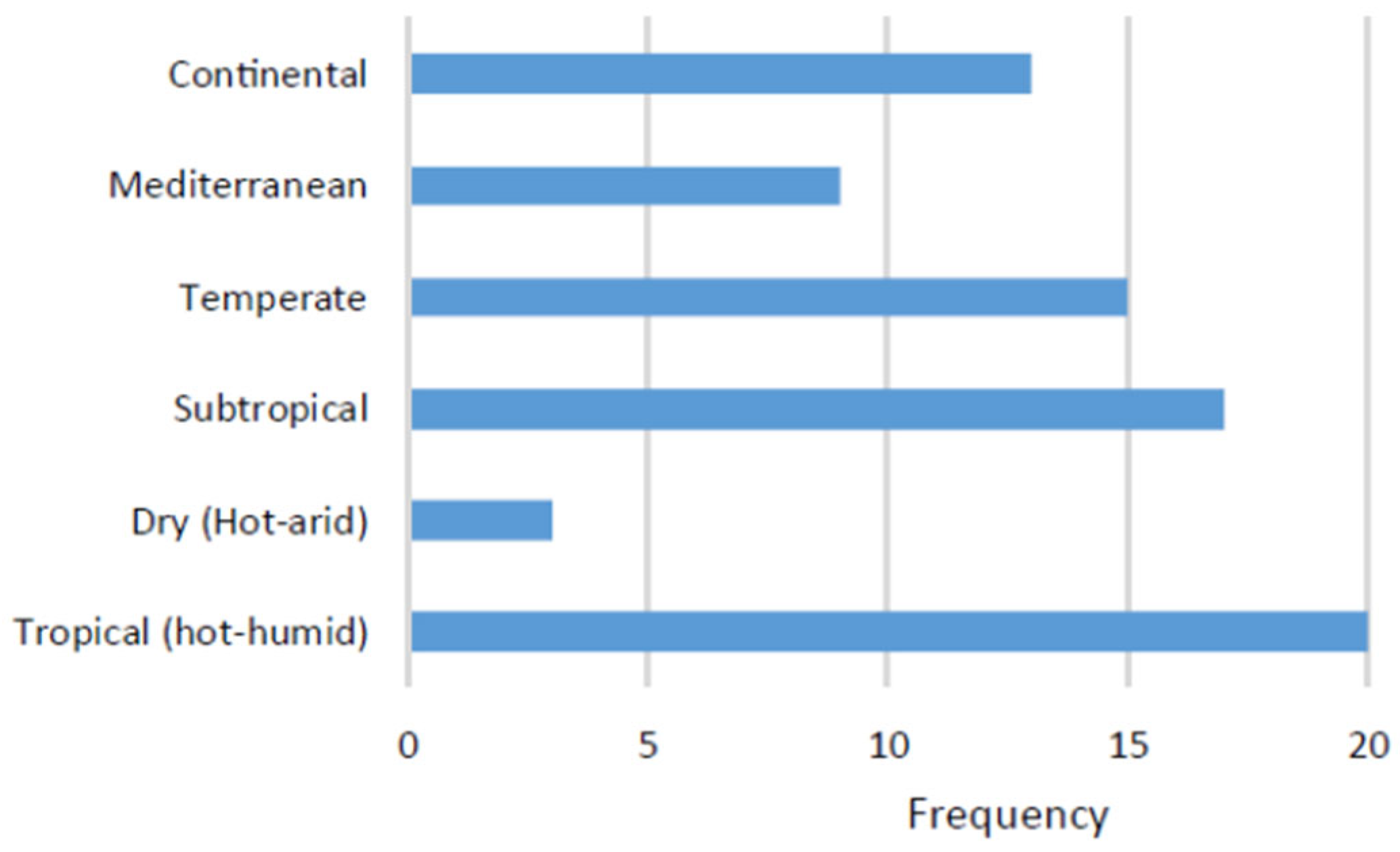

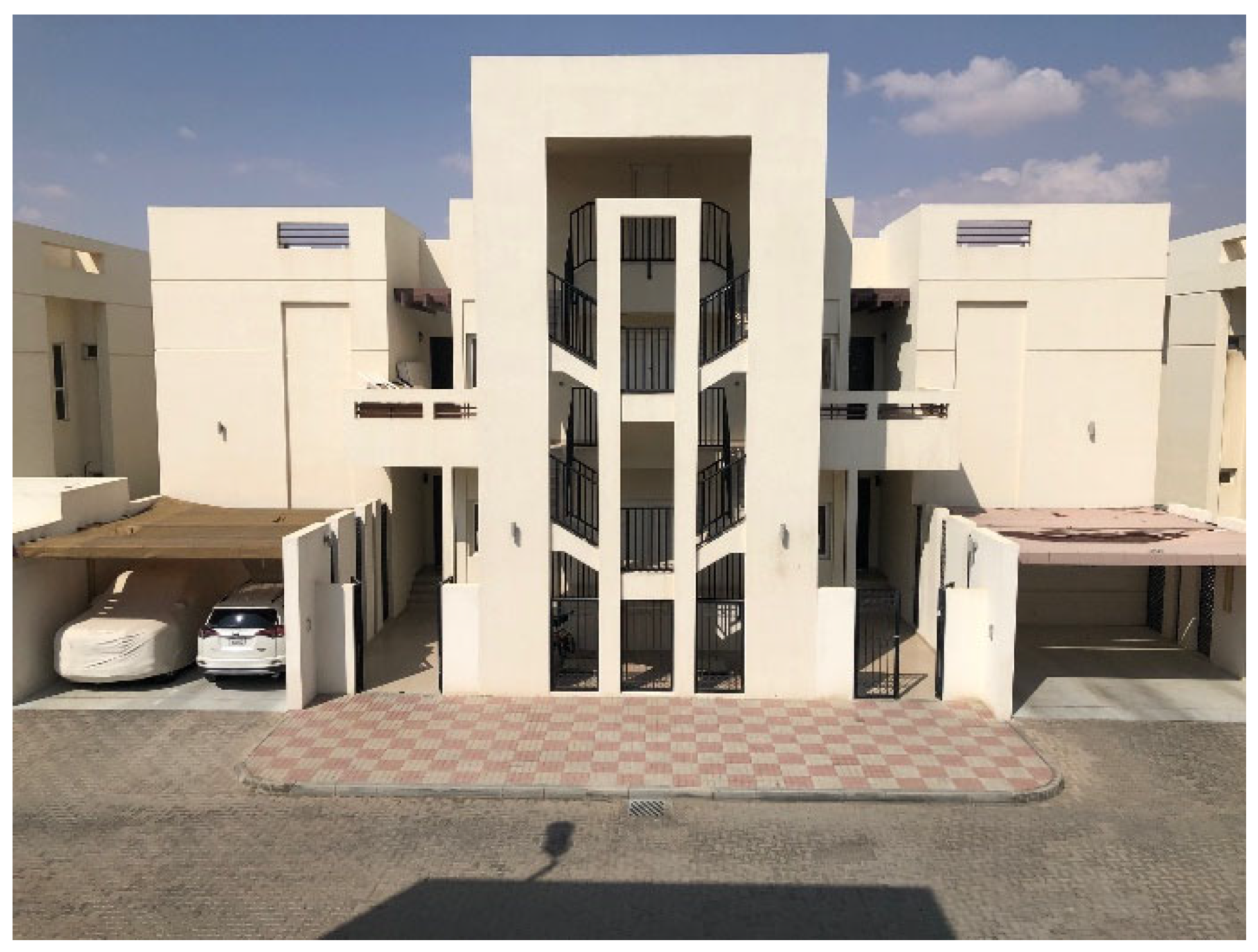

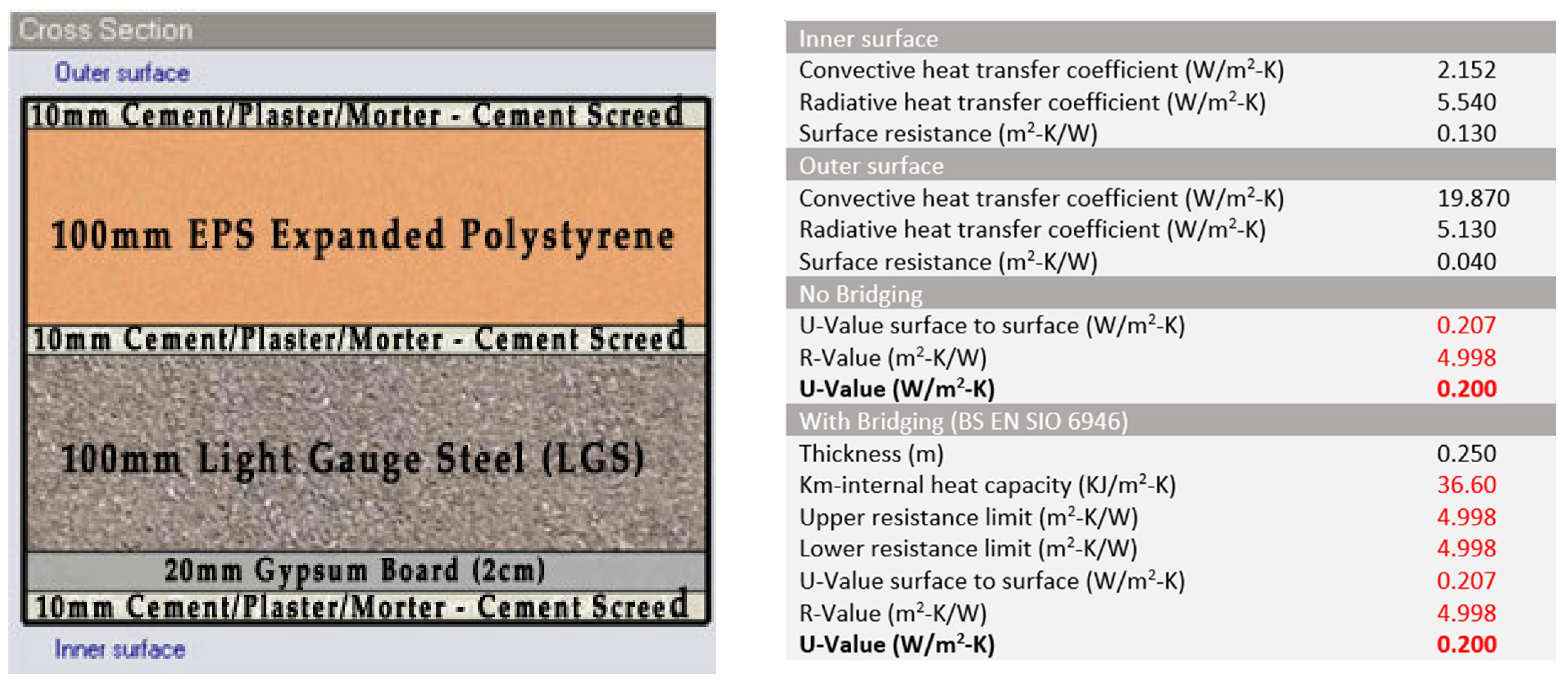

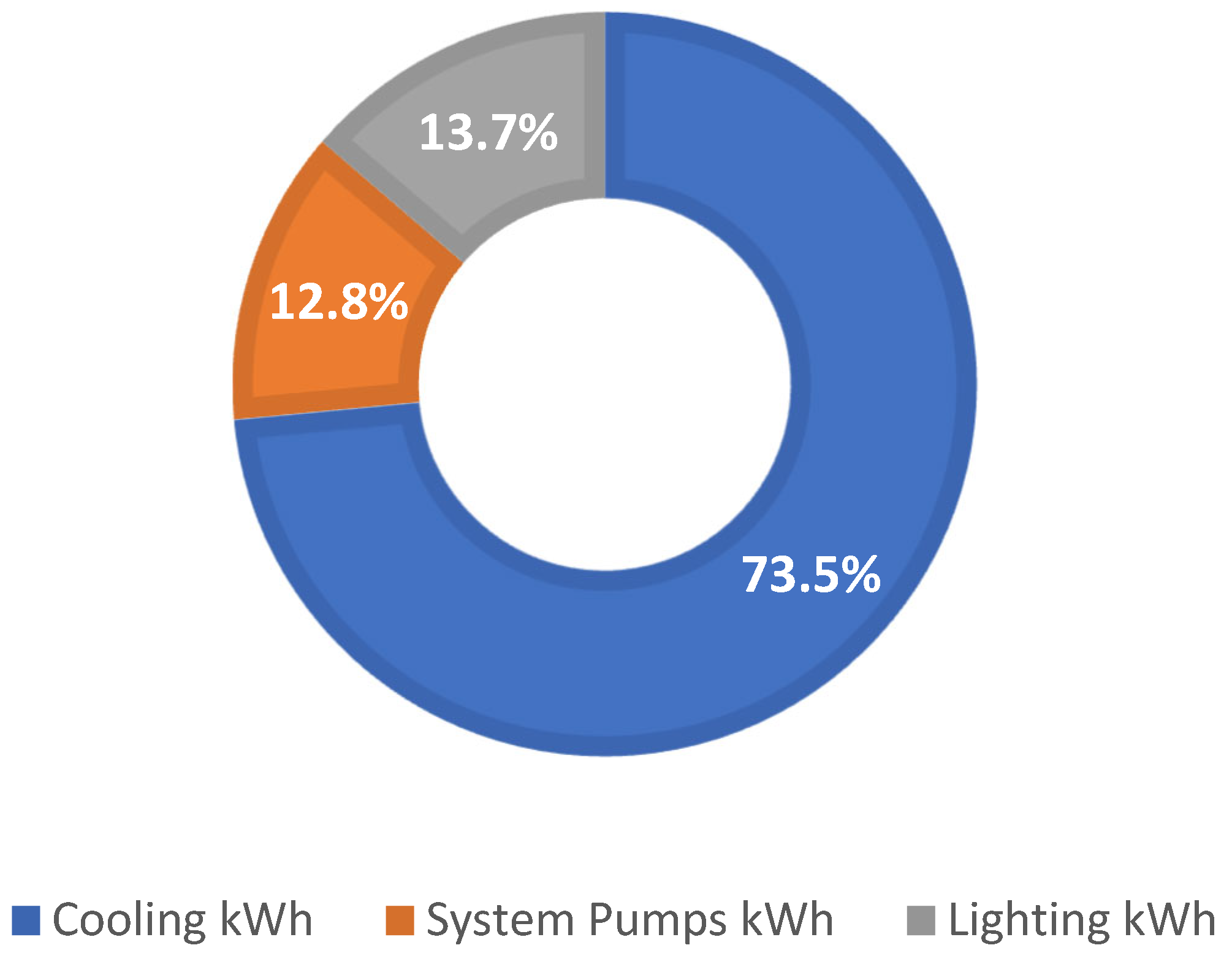
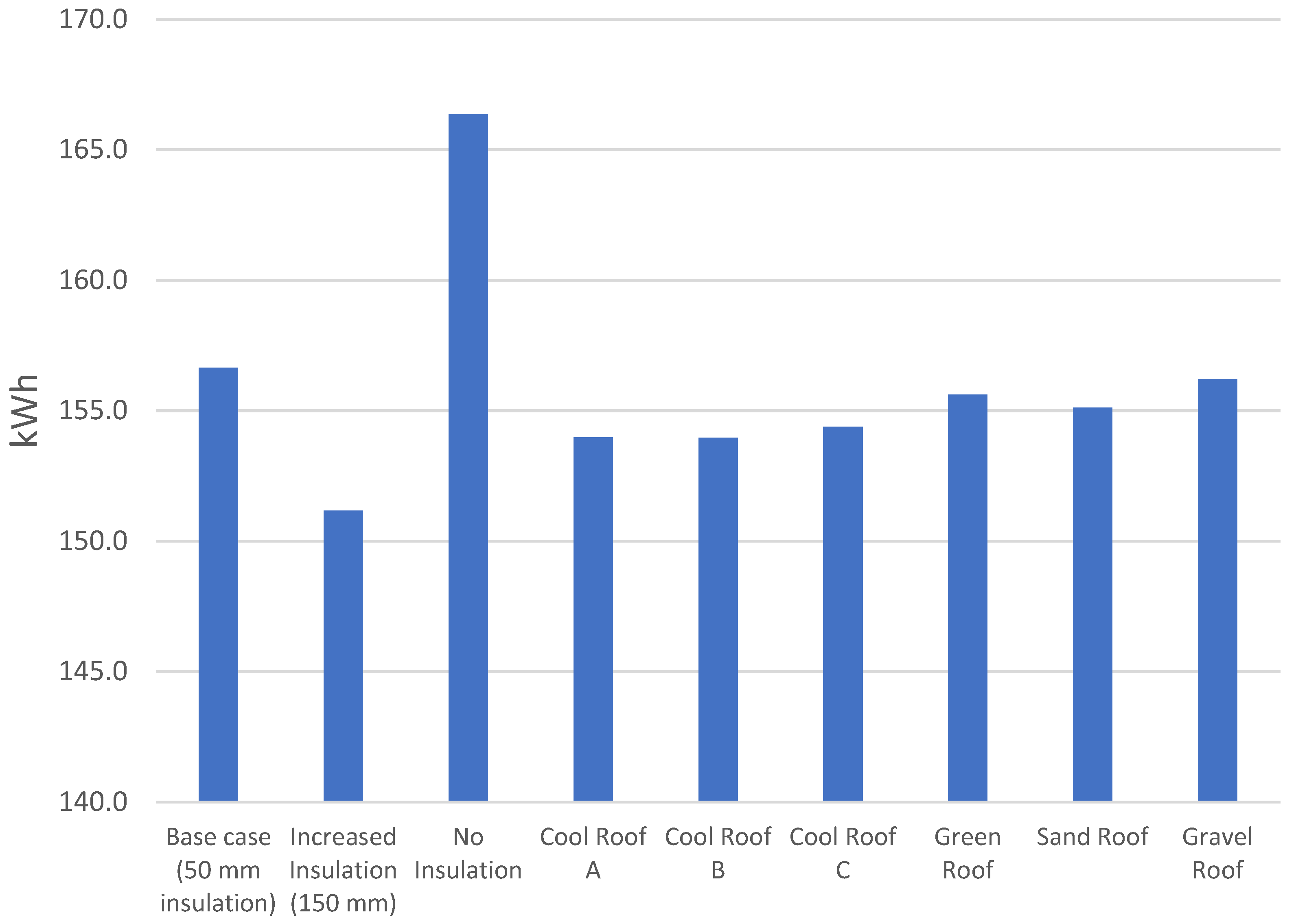
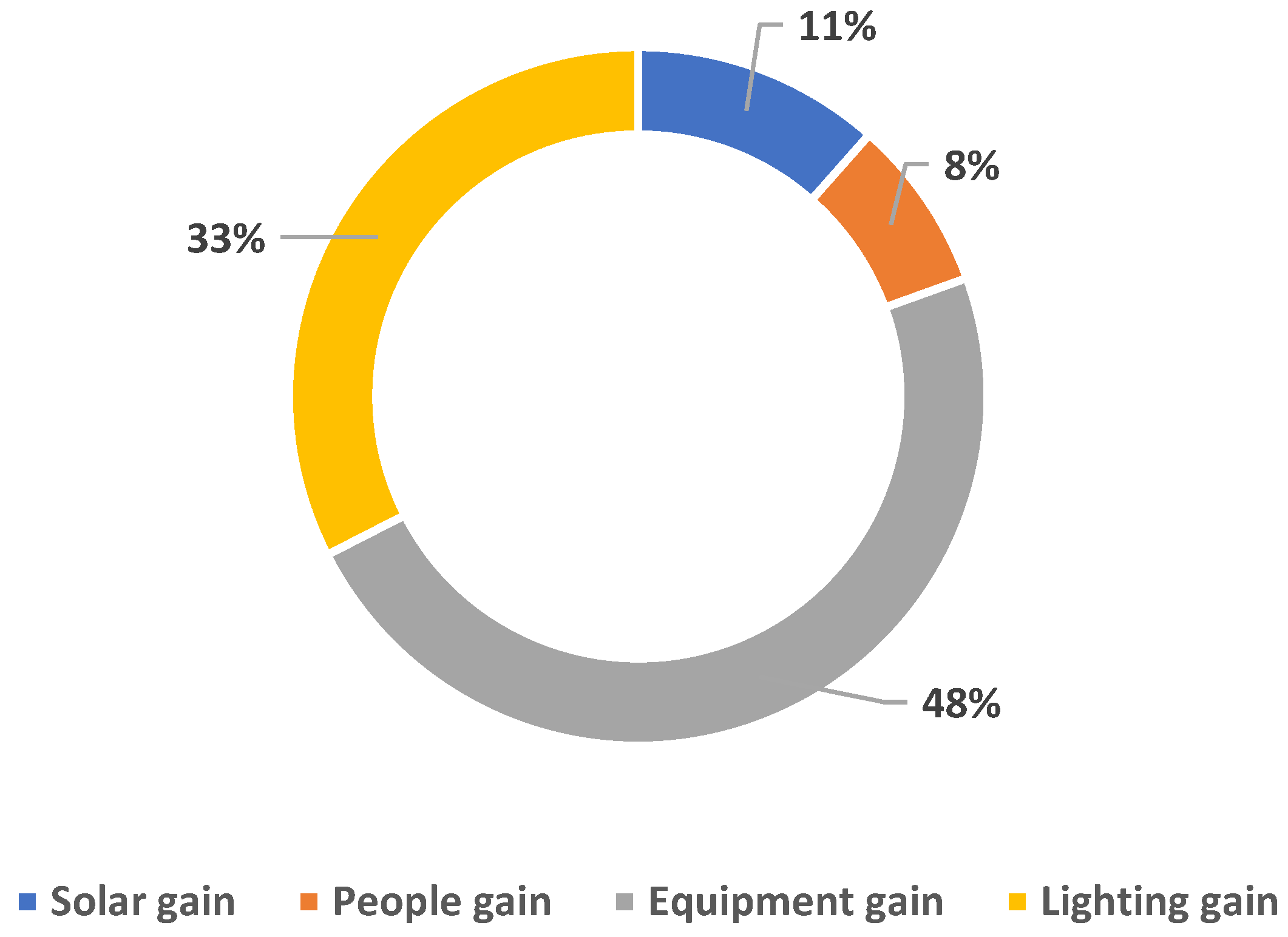
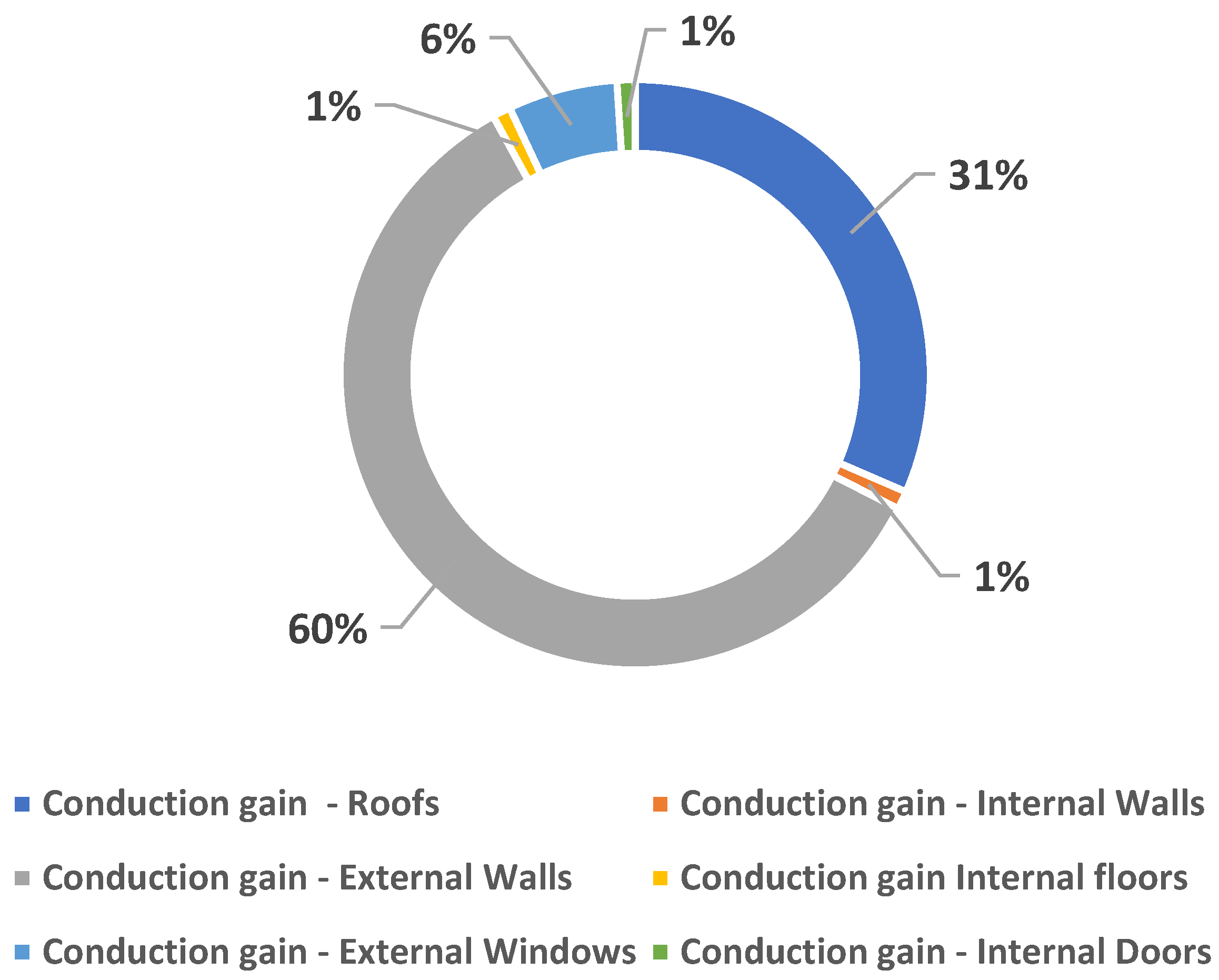
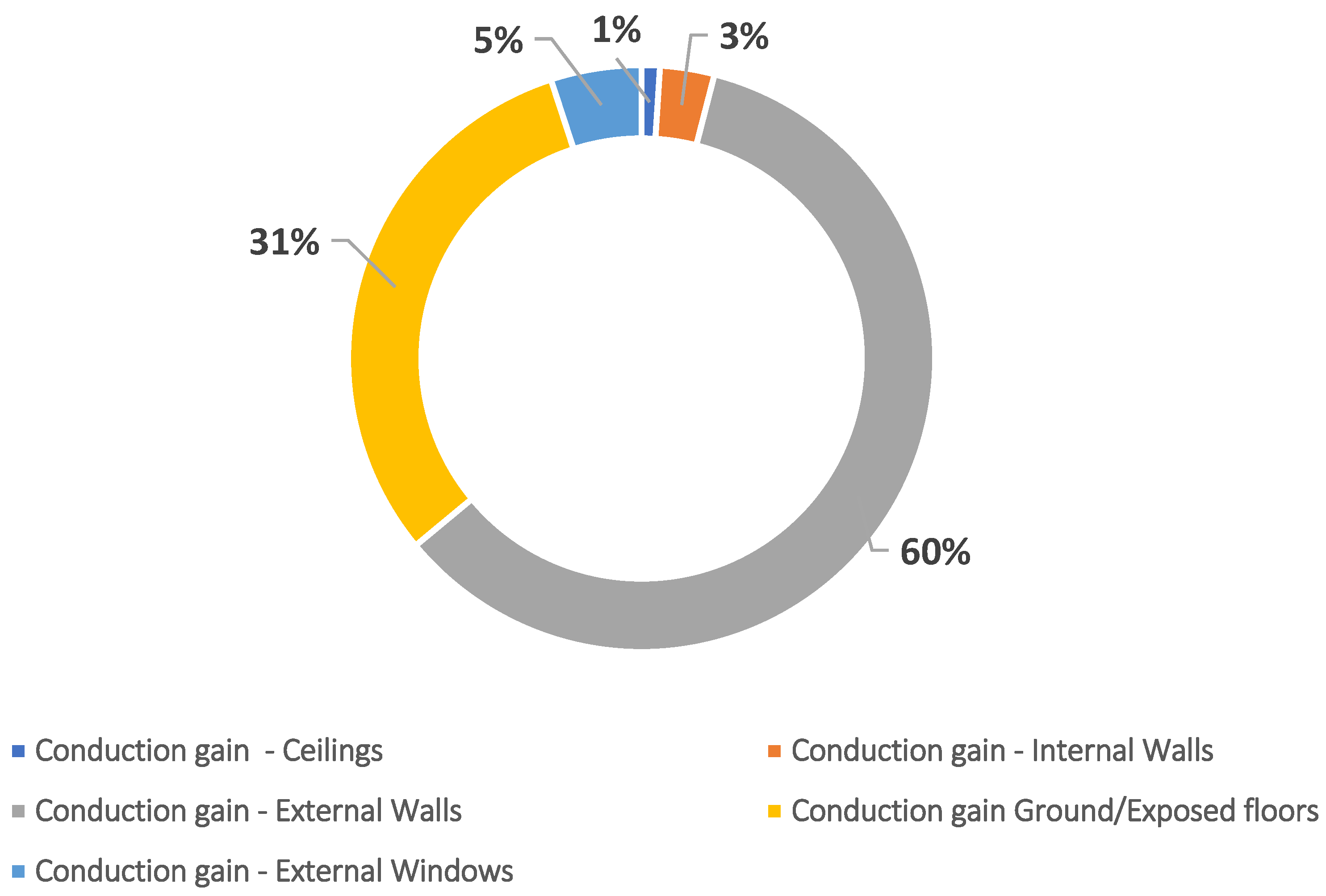
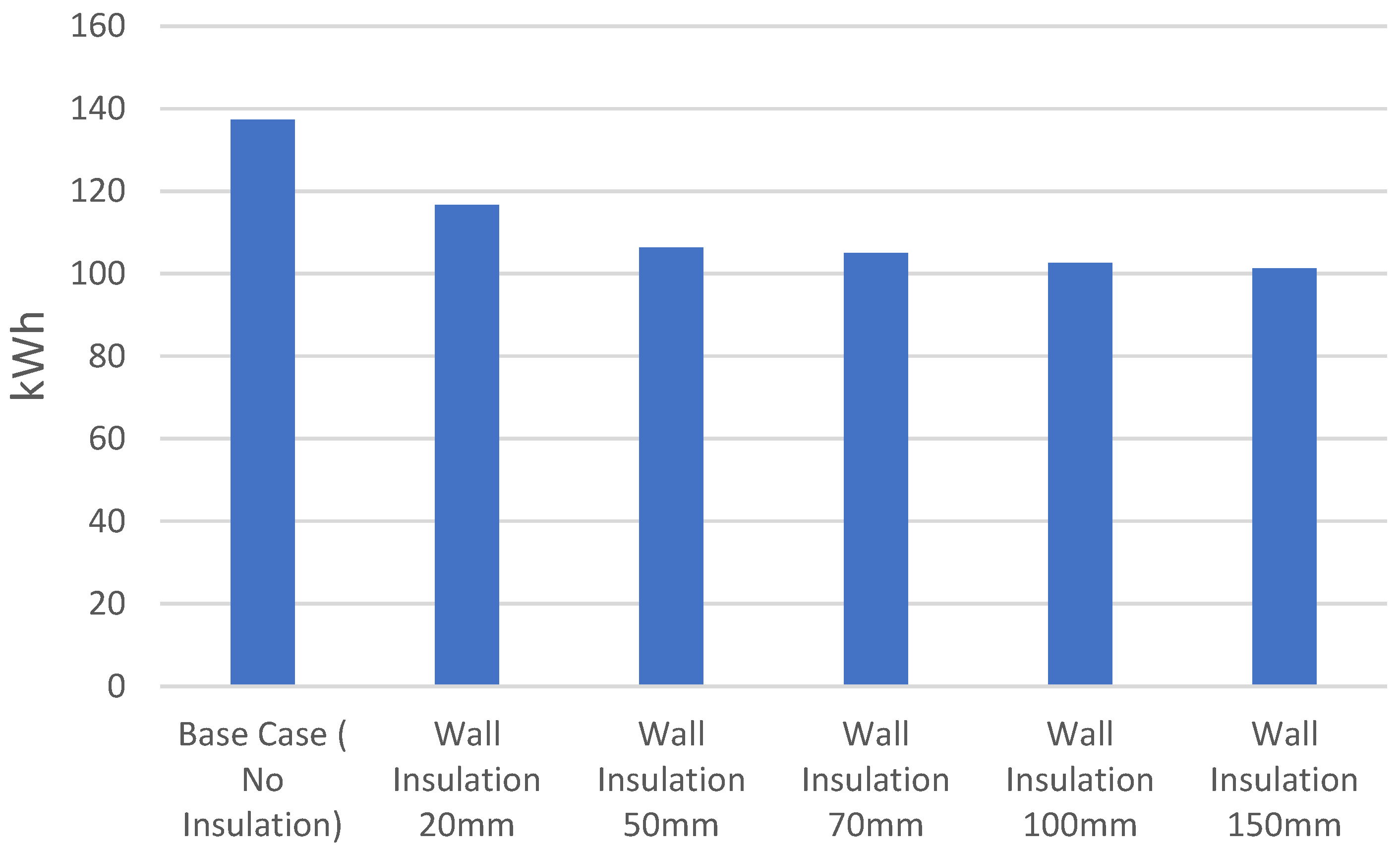
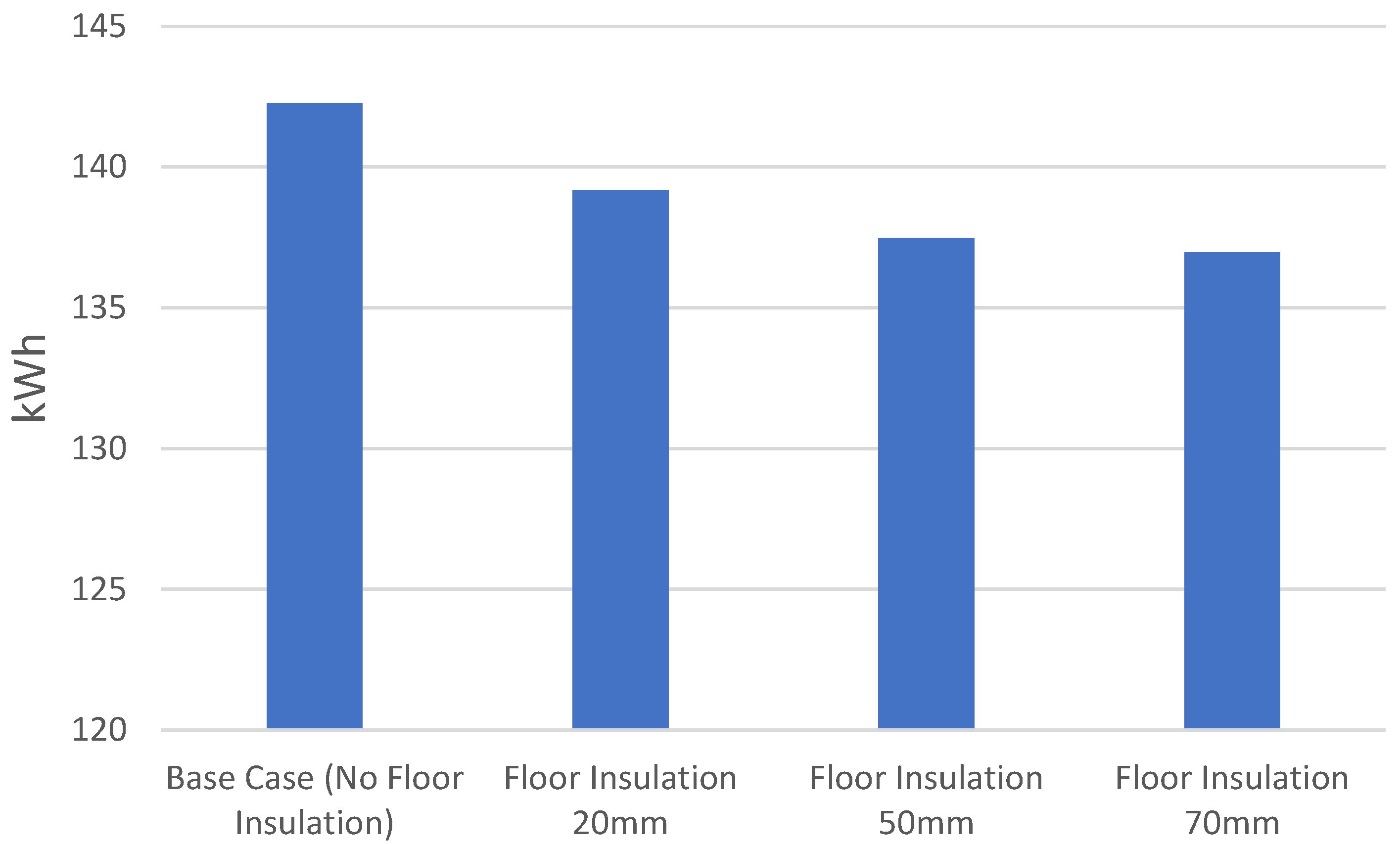

| Design Element | UAE, Abu Dhabi ESTIDAMA 1 Pearl Compliance [46] |
| Exterior Walls | Massive wall U = 0.30 W/m2-K |
| Roof | Insulation entirely above deck U = 0.20 W/m2-K |
| Floor | Massive floor U = 1.65 W/m2-K |
| Glazing | Double coated 6/8/6 (SHGC 0.31) U = 3.1 W/m2-K |
| Occupancy density | Five occupants |
| System type | Constant Volume DX |
| Thermostat setting | 24 °C for cooling (no heating is provided) |
| Cooling system seasonal Coefficient of Performance (CoP) | 3.2 |
| Infiltration | 3.64 l/s/m2 of exterior surface area |
| Building Feature | Modeling Scenario | ||||||||
|---|---|---|---|---|---|---|---|---|---|
| Roof | Base case | Add insulation | Cool roof | Gravel assembly | Green roof | ||||
| Wall | Base case | Five insulation thickness scenarios | |||||||
| No insulation | 20 mm | 50 mm | 70 mm | 100 mm | 150 mm | ||||
| Floor | Base case | Three insulation thickness scenarios | |||||||
| No Insulation | 20 mm | 50 mm | 70 mm | ||||||
| Window | Base case | Four schemes with different U- and g-values | |||||||
| U value 3.1, g value 0.4 | U value 3.1, g value 0.2 | U value 2, g value 0.5 | U value 1.6, g value 0.4 | U value 1.0, g value 0.4 | |||||
| Cool Roof | Gravel Assembly | ||||
|---|---|---|---|---|---|
| Maker A | Maker B | Maker C | Coarse | Sand | |
| Material | SBS with polyester reinforcement | SBS with polyester reinforcement | APP with polyester reinforcement | Grain size (8–22.4 mm) | Grain size (0–4 mm) |
| Thickness | 4 mm | 4 mm | 4 mm | 2 cm | 2 cm |
| Reflectance | 0.78 | 0.83 | 0.72 | 0.36 | 0.44 |
| Emissivity | 0.89 | 0.91 | 0.92 | 0.56 | 0.64 |
| Properties | Value |
|---|---|
| Thermal Conductivity (W/(m_K)) | 0.3 |
| Height of Plants (m) | 0.3 |
| Leaf Area Index (LAI) | 5 |
| Leaf Reflectivity | 0.4 |
| Leaf Emissivity | 0.95 |
| Minimum Stomata Resistance (s/m) | 50 |
| Maximum Volumetric Moisture Content at Saturation | 0.5 |
| Minimum Residual Volumetric Moisture Content | 0.2 |
Disclaimer/Publisher’s Note: The statements, opinions and data contained in all publications are solely those of the individual author(s) and contributor(s) and not of MDPI and/or the editor(s). MDPI and/or the editor(s) disclaim responsibility for any injury to people or property resulting from any ideas, methods, instructions or products referred to in the content. |
© 2024 by the authors. Licensee MDPI, Basel, Switzerland. This article is an open access article distributed under the terms and conditions of the Creative Commons Attribution (CC BY) license (https://creativecommons.org/licenses/by/4.0/).
Share and Cite
Elnabawi, M.H.; Saber, E.; Bande, L. Passive Building Energy Saving: Building Envelope Retrofitting Measures to Reduce Cooling Requirements for a Residential Building in an Arid Climate. Sustainability 2024, 16, 626. https://doi.org/10.3390/su16020626
Elnabawi MH, Saber E, Bande L. Passive Building Energy Saving: Building Envelope Retrofitting Measures to Reduce Cooling Requirements for a Residential Building in an Arid Climate. Sustainability. 2024; 16(2):626. https://doi.org/10.3390/su16020626
Chicago/Turabian StyleElnabawi, Mohamed H., Esmail Saber, and Lindita Bande. 2024. "Passive Building Energy Saving: Building Envelope Retrofitting Measures to Reduce Cooling Requirements for a Residential Building in an Arid Climate" Sustainability 16, no. 2: 626. https://doi.org/10.3390/su16020626
APA StyleElnabawi, M. H., Saber, E., & Bande, L. (2024). Passive Building Energy Saving: Building Envelope Retrofitting Measures to Reduce Cooling Requirements for a Residential Building in an Arid Climate. Sustainability, 16(2), 626. https://doi.org/10.3390/su16020626







